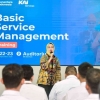By: Agung Ruslan (UIN Sunan Gunung Djati Bandung MPI Study Programme Class-3D)
In this fast-paced digital era, Indonesia's education sector faces a paradox. Data from Statistics Indonesia (2022) shows an increase in school enrolment rates, but on the other hand, a report from the Ministry of Education, Culture, Research and Technology reveals challenges in the efficiency and accountability of education data management. The assumption is that technology has touched all aspects of life, including education. However, in reality, there is still a wide gap between the expectations of modern education and the practice of institutional management, which still relies on manual and fragmented systems. The main problem lies in the fragmentation of data on students, teachers, finances, and assets, which leads to slow strategic decision-making and resource inefficiency. Therefore, this essay aims to raise awareness of the strategic role of the Education Management Information System (SIM) as the answer to the challenges of digital transformation in the education sector.
In essence, this transformation is not just about providing computers or internet networks. It is about building an integrated information ecosystem. The main characteristic of the Education SIM is its ability to present relevant, accurate, and timely information. Imagine if a head of department could monitor the actual number of teachers, study groups, and budgets in all schools through a single centralised dashboard. Information that was previously scattered across various ledgers and unconnected Excel files can now be integrated into a solid basis for planning.
An effective Education SIM is built on five complementary components: hardware, software, human resources (brainware), data, and procedures. The biggest challenge is often not the technology, but the readiness of the brainware---namely, school principals, teachers, and educational staff---to transition from a manual work culture to a structured digital culture. Training and a change in mindset are key in this component.
In terms of structure, SIM serves various levels of management. At the operational level, SIM automates routine tasks such as inputting student grades and attendance. At the managerial level, SIM generates analytical reports for monitoring and evaluation by school principals. At the strategic level, SIM becomes a Decision Support System (DSS) for policy makers in education agencies or ministries to formulate empirically-based policies, such as analysing the need for new school construction or teacher distribution.
Its implementation has already begun, for example through the Education Management Information System (EMIS) within the Ministry of Religious Affairs. The success of digital transformation in education is highly dependent on an integrated approach, where all components and levels of the structure are synergised. By adopting SIM, educational institutions not only improve efficiency, but also build a foundation for education that is more transparent, accountable, and ready to face future challenges.
-----------------------------------
*) This article is summarised from the Teaching Module for the Educational Information Management System Part-4 Postgraduate Course at UIN SGD Bandung, MPI Class -3D, Lecturer Prof. Rusdiana.
Follow Instagram @kompasianacom juga Tiktok @kompasiana biar nggak ketinggalan event seru komunitas dan tips dapat cuan dari Kompasiana. Baca juga cerita inspiratif langsung dari smartphone kamu dengan bergabung di WhatsApp Channel Kompasiana di SINI





